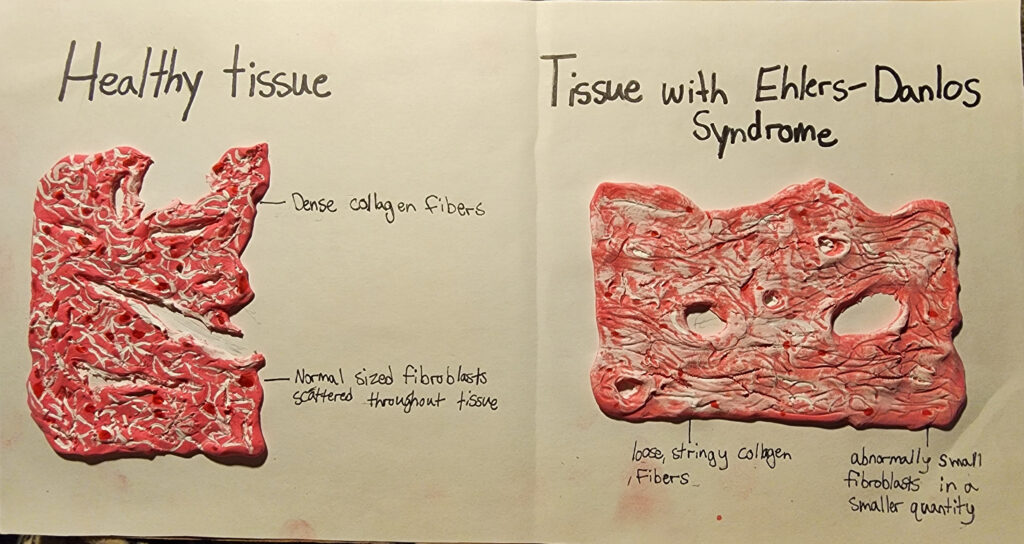
My STEAM project explores Classical Ehlers-Danlos syndrome, which is a disease that affects connective tissue in the body (Mayo Clinic, 2022). This topic mainly relates to the, “Compare and contrast the function and structural characteristics of tissues,” objective. My art project models what the connective tissue of a health person and the connective tissue of a person with Ehlers-Danlos syndrome looks like, and lets the viewer compare the two. In explaining how Ehlers-Danlos syndrome affects connective tissue, I am also comparing and contrasting the function and structural characteristics of tissues.
Ehlers-Danlos syndrome (EDS) is a group of conditions that are genetically inherited. This project focuses on the classical type specifically. The syndrome causes connective tissue to be very weak, which causes a variety of health issues. For instance, people with EDS have very stretchy and fragile skin that has a difficult time healing (MedlinePlus, 2022). This is due to the weakness of the connective tissue. Another problem that comes along with EDS is hypermobility and, as a consequence, increased risk of dislocation of joints. This is because connective tissue is usually what holds bones at joints in place (along with ligaments), but if the tissue is not strong enough to hold the bones, then it becomes far easier for those bones to slip out of their proper spots (Mayo Clinic, 2022).
The reason that people with EDS have very weak connective tissue is because of variations in their genes. The COL5A1, COL5A2, or COL1A1 genes are ones usually seen with variants when discussing classical EDS, but other genes may also play a part (Gensemer, 2021). These genes are involved in instructing the body on how to make different types of collagen, so when the genes do not have the correct instructions, the body does not make collagen in the way that it is supposed to (MedlinePlus, 2022). Collagen is a very important part of connective tissue, as it provides a lot of support, structure, and rigidity. Normal collagen is also resistant to stretching, which, of course, is contradictory to the main symptoms of EDS (Wu et al., 2023). This shows us that it makes sense that a lack of normal collagen would make connective tissue significantly weaker, which would cause the previously mentioned symptoms of stretchy and fragile skin, along with hyper-mobile joints.
In my models of connective tissues, I attempted to show how normal collagen is packed tightly together, which is in contrast to the more stretched out collagen in EDS connective tissue. I also think it is interesting that the collagen in EDS connective tissue seems to go in more of a single direction instead of the irregular directions of the collagen in normal connective tissue. The EDS tissue is also lighter and almost looks softer than the regular connective tissue. I believe that the connective tissue shown in the reference image I used is loose connective tissue based on the large amount of ground substance and, of course, collagen in the tissue.
In summary, Ehlers-Danlos syndrome is an interesting but unfortunate disease. It has some significant effects on collagen in the body’s connective tissue, which in turn causes serious problems for those who have the syndrome. I enjoyed creating my STEAM project, and I’m glad I chose this topic.
